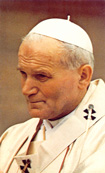|
 Announcing
each mystery Announcing
each mystery
 29. Announcing each mystery, and perhaps even using
a suitable icon to portray it, is as it were to open up a scenario on which to focus
our attention. The words direct the imagination and the mind towards a particular episode
or moment in the life of Christ. In the Church's traditional spirituality,
the veneration of icons and the many devotions appealing to the senses,
as well as the method of prayer proposed by Saint Ignatius of Loyola in the
Spiritual Exercises, make use of visual and imaginative elements (the compositio
loci), judged to be of great help in concentrating the mind on the particular mystery.
This is a methodology, moreover, which corresponds to the inner
logic of the Incarnation: in Jesus, God wanted to take on human features.
It is through his bodily reality that we are led into contact with the mystery
of his divinity. 29. Announcing each mystery, and perhaps even using
a suitable icon to portray it, is as it were to open up a scenario on which to focus
our attention. The words direct the imagination and the mind towards a particular episode
or moment in the life of Christ. In the Church's traditional spirituality,
the veneration of icons and the many devotions appealing to the senses,
as well as the method of prayer proposed by Saint Ignatius of Loyola in the
Spiritual Exercises, make use of visual and imaginative elements (the compositio
loci), judged to be of great help in concentrating the mind on the particular mystery.
This is a methodology, moreover, which corresponds to the inner
logic of the Incarnation: in Jesus, God wanted to take on human features.
It is through his bodily reality that we are led into contact with the mystery
of his divinity.
 This need
for concreteness finds further expression in the announcement of the various mysteries
of the Rosary. Obviously these mysteries neither replace the Gospel nor exhaust its content.
The Rosary, therefore, is no substitute for lectio divina;
on the contrary, it presupposes and promotes it. Yet, even though the mysteries
contemplated in the Rosary, even with the addition of the mysteria lucis,
do no more than outline the fundamental elements of the life of Christ,
they easily draw the mind to a more expansive reflection on the rest of the Gospel,
especially when the Rosary is prayed in a setting of prolonged recollection. This need
for concreteness finds further expression in the announcement of the various mysteries
of the Rosary. Obviously these mysteries neither replace the Gospel nor exhaust its content.
The Rosary, therefore, is no substitute for lectio divina;
on the contrary, it presupposes and promotes it. Yet, even though the mysteries
contemplated in the Rosary, even with the addition of the mysteria lucis,
do no more than outline the fundamental elements of the life of Christ,
they easily draw the mind to a more expansive reflection on the rest of the Gospel,
especially when the Rosary is prayed in a setting of prolonged recollection.
|

